|
... And I ask forgiveness for my would-be omniscient judgments in these endless musings, which are of course all my own, and in addition appear to have no common ground with almost all decent thinking regarding sampling and tone generation, and organs for that matter. ... At least I know what I like: I am a home organist; I think the Nord C2 makes an excellent home organ, with the addition of a few amazing and amusing accessories — most importantly, amplification / speakers — that I will blather about endlessly. I have no professional pretensions, Heaven knows; I enjoy sitting at my somewhat eccentric lash-up playing music, badly. I believe our world would be a better one if more people did that, but I could easily be wrong. ... For instance, they probably wouldn’t really have to play badly.... VIRTUAL EXCUSES: BUTTONS, KNOBS, CONTROLS ’n’ CONSOLESWhen I began my Nord C2 pilgrimage in 2011, elaborate consoles and herds of loudspeakers ruled at the VTPO forum, where the most dedicated and visible of virtual organists assembled, craving not only vast audio resources but also substantial “authentic” consoles to such an extent I feel I have to apologize for my simpler tastes. ... But at least some of the photos @ pcorgan.com (down the page of course) betray similar regrettable tendencies, which may well represent the virtual silent majority, quietly enjoying theater/classical virtual pipe organs played on systems without the slightest pretense to historic authenticity or even resemblance. A letters-column spat in the 5/13 ATOS Journal (Vox Humana, also previous issues) saw the virtual forces defending fiercely their cause against a previous issue’s epistle demanding a pipe-only ATOS. The virtualistas’ unanimous professed goal was something just like a real theater organ, which is ridiculous if endearing, and to be sure there were concessions that such might be an ideal. A secondary line was the need for practice. And the letter writers might indeed have included an unusual concentration of actual theater organists; but the realities of this sad mortal world are even for them there are only a few theater organs and it is unacceptably costly just to turn the things on, so actual theater organ hours played will be overwhelmingly on virtual instruments or worse. But no one stood-up for playing a home instrument that sounds kind-of like a theater organ just for fun, despite the likely prevalence of such an unwholesome practice. So I will. My simple audio ideas are, approximately, adequately louder than too loud. And if I had a vast heated / air-conditioned barn, I’d love a few 3- or four-manual consoles. Which’d still be inherently limiting, the obvious case being the theater organ versus the Orgelbuchlein — although I finally played Das Alte Jahr Vergangen Ist on the Miditzer with a reed and a tremolo tibia and it was ravishing. ... But nevertheless, the Deity gave us computers and computerized equipment like the Nord C2 just so such limitations could be minimized, and I want that luxury, and could easily ignore the sultry call of the giant console for that reason alone if sloth were not enough. 
THE CONSOLE BURDENThe console-obsessed must enjoy the musical impediments they put in their own way, with their endless intricate wiring projects and 3- or four-manual consoles of varying decrepitudes. ... A perennial thread at the VTPO forum went on and on about console tab-flipping relays (SAMs?) — I’ve actually seen the full raging debate twice! ... Conventional power supplies with huge capacitors versus a battery and/or sometimes-menacing “super caps”: which best to supply the massive currents to reliably flip all the tabs to off with the cancel button and make a satisfying clonk. ... An apostate averred he would clonk no more and use indicator LEDs, but he was the minority while the others joyously pursued the hunt with glad shouts. ... I suspect these devoted afficianados wouldn’t think much of my store-bought equipment.... CHEAPLike an innocent child, I imagined
my
beautiful Nord cost more
than the hobbyists’ keyboards, consoles, MIDI
boards, and vast
wandering herds of audio equipment, but it’s really quite the opposite,
reminding me of the time I encountered some good old boys helping out
at the hay
bailing or something only to realize with intense embarrassment that
they were the local millionaires
dressed in fashionable rural custumes. ...
The Nord
Imperium,
particularly enhanced as it is with
the ravishing beauty and flakiness of the virtual
organs, is hardly
perfectly reliable, but it does not arouse anxiety
in the way of my attic
instrument of the
past ... usually. I can almost
always
turn the Nord on, and it works!
— without
hours of audio/MIDI
debugging. ... I play as badly as
ever
because I
play
badly;
not because some new wacko
thing has gone wrong. ... But I suppose most
of the organistas play much better than I do, at least I certainly hope
so, and
FLAKE ONThe advent of the beautiful virtual theater organs may have had as much to do with my new-found musical enthusiasms as more-reliable hardware. Indeed, I didn’t start to try and play “pop” theater-organ style stuff until the glorious Nord, and especially the Mitz & Hauptwerk. ... Pathetically, the attic assemblage was pretty much strictly classical. ...
But the
“flake factor” still lurks, and showed-up at my latter-day
tiny
keyboard triumph
which involved a
tottery keyboard perched
up where it didn’t
belong. ... As
well
as
Christmas bells, I got it to play the Miditzer
260sp
“toy counter”
so I could round-out a rousing performance with a
gong (along with clangorous chimes on a regular manual). ... The bells
& chimes I subdued eventually with my dangerous third
keyboard, but the gong & drums really called for
something like
a real theater organ’s toe
FLEA MARKET SPINETSBut pitifully
I sometimes still yearn for one
of
those adorable little horse-shoe electronic home
spinet things of
yore. I actually saw one in a flea market ... I suspect at least some of the hard-core virtualistas abhor my beloved home electronic organs because they’re reminded of the detested plastic phony-wood “culture” of their dumb parents, but my dumb parents were proud forerunners and already detested that stuff for which, of course, I’ve developed a perverse fondness. ... And I was severely tested, here in the spiritual homeland of discarded home organs, where Craigs list was overflowing with such, just a few minutes and a truckload or so away. And I gaze at the pictures, and even save the odd pin-up, to hang around my Nord Imperium — but I rent no truck. ... And it appears I waited for too many precious years, and now (6/21) the organs seem to be scarce, neglectful me.... Anyway, the sounds of those things were mostly disappointing: my DK40 flute was heart-breakingly lovely, but the other voices weren’t, and I don’t know if I’d be able to stand those 70s renditions of the theater organ now that I’m been spoiled by the digital magic of Miditzer and Hauptwerk; to my shame, I sometimes even neglect my beloved chord organ. ... And, as I keep forgetting, the lovable old spinet consoles usually didn’t have reverberation, to my cringing retrospective horror. ... I suppose I could always add my super-after-market reverb....
|
|
In
an unimportant way, my life has embodied the
decline
and fall of the king of instruments, at least the sad part at the
end. ... I was instructed in the art — but assiduously never learned
— by Mr. Severtson, the
kindly blind
organist @ St. Peter’s. ... Indeed, I just realized while composing
these notes
the only reason he put up with me was he couldn’t get anybody else!
...
Pipe organ rot had set in well by then, figuratively and actually, and
I have absolutely no idea why my youthful fancy was so attracted to the
thing, although my mother, like so many, was
an organist back in the midwest. Although you’d think her militant
atheist futurist super modernism wouldn’t’ve encouraged that
sort of
thing — well, that’s probably it! — |
|
My home organ adventures were not without shadow, cast mostly by the speakers for my beautiful Nord C2 or, more correctly, their absence; the Nord C2 is of course supplied without speakers or amplifier. ... My early attempts with a pair of Behringer B1031A amplified “studio” monitors were fated to be too soft even with a lovely subwoofer. I note, with groveling humility, the VTPOers would’ve doubtless snickered; they favor much more splendiferous Behringers, and I don’t think they can count as low as two.
... But in my dark reflections, it occurs to me no organ speakers will ever be really adequate — compared to, say, standing on the pedals and mashing the keys on even my relatively small St. Peter’s organ: pipes are just too loud. ... Of course you’d only do that if you were a bad person, or playing contemporary music. ... There was a comment in the VTPO forum where a fellow said he had 6 sub-woofers and a physical “shaker” aka “butt kicker”, in an effort to emulate a 32’ theater organ pipe. The St. Peter’s organ of my youth stopped at 16’ — but I can remember playing that thing as a teenager, how I could feel that low pedal 16’ C — no standing on the pedals required.
... Needless to say, my subwoofer does not provide that effect, nor do I intend to augment it in pursuit of such. ... And in modern times I’ve finally attended a theater organ concert or two, with a real Wurlitzer, and I can still feel the pipes, and that’s probably the way it oughtta be....
But my right-side studio monitor buzzed! ... Pitifully I crawled around the floor, and I could hear it in the metal plate on the back, as well as feel it. Without much effort I was able to tighten many of the screws fastening the plate to the wooden speaker back. A subsequent Brit music magazine tip ’n’ trick suggested regular monitor screw tightening so I guess it’s perfectly normal.
... And indeed, in my ridiculous attic studio I had a decades-old Yamaha bookshelf speaker which, speak of the devil, started buzzing a few weeks before the behringer, at a sine-wavish A4 — from the intense “bell” tones of a VSTi I used in my glorious silver bell adventures, as it happens. ... When I tracked that one down, I found it @ the mid-range of the right speaker, and “fixed” it by unscrewing the thing and putting electrical tape around the hole: the plastic tape was “gooey” enough to provide a little gunk barrier to the senile buzzing. I vaguely recall at least some speaker manufacturing included the application of official gunk for this very purpose — anti-buzz gunk — and perhaps Yamaha’s dried-out over the weary years. ... But the Behringer took only a month!...
When the Behringer screws lost their “stick” entirely and’d just whirl around in the hole, I used the old toothpick trick: I broke off about an inch or so of a toothpick and stuck it in the screw hole with a little bit of the pointy part out, and then screwed the bad screw in, which then proceeded to behave like a quality-controlled regular screw mechanism! ... This with two screws so far, so Behringer 0, toothpicks 2....
 A
WOLF NOTE?
A
WOLF NOTE?I
didn’t believe in standing waves.
Or fairies — when they’d ask the kids to clap for tinkerbell,
I’d
just
snarl. ... But today, I
believe in standing
waves.
... There was a “wolf” note on the Nord
pedal F; annoying,
loud. Particularly annoying
on the pipe organ, but still quite noticeable in the B3 emulation. And
I recklessly blamed the Behringer monitors! ... The 16’
low
F is 43.65 Hz, which I decided was a typical bass
reflex frequency; even ’though Behringer included a beautiful
frequency
chart showing no such bump! ... But I didn’t
believe.
... So I got an EQ
gadget![[9]](nine.png) to crush the speaker’s supposed nasty port note. And I
dutifully
dialed-down 40 Hz and — nothing!
... 80 Hz
on the other hand —
the F an octave higher — and presto! Wolf note gone! ... And
that
F has a wavelength
of about 13 feet; which turns-out to be the dimension
more-or-less of the living room right around the beautiful Nord. ...
But then I read more
about room effects, and suspect my diagnosis is more of a
faith-based thing. ... But whatever, that
low F was too
loud, and the EQ fixed it!
to crush the speaker’s supposed nasty port note. And I
dutifully
dialed-down 40 Hz and — nothing!
... 80 Hz
on the other hand —
the F an octave higher — and presto! Wolf note gone! ... And
that
F has a wavelength
of about 13 feet; which turns-out to be the dimension
more-or-less of the living room right around the beautiful Nord. ...
But then I read more
about room effects, and suspect my diagnosis is more of a
faith-based thing. ... But whatever, that
low F was too
loud, and the EQ fixed it!

My organ was still too wimpy, so the next step was a “Polk Audio PSW505 12-Inch Powered Subwoofer”. ... The typical VTPO fanatic would’ve figured a subwoofer from the start, and now you know at least — but I didn’t. ... Aprés subwoofer installation, a few times I merrily started incompetently playing a chorale prelude, and got through without noticing the subwoofer was off while I absently mused on how I should turn the thing up! ... I take this as evidence of merit: it suppressed — because I turned-down the bass on the studio monitors — various annoying distortions and, as it happens, the actual bass enhancement is subtle-enough, at least with the orgelbuchlein. ... Although to be sure, it sounded better when I turned it back on — and louder....
Playing, badly as ever, I Can’t Give You Anything But Love on the Hauptwerk Paramount 310, my latter-day electronic home organ in its Polk PSW505 sub-woofered incarnation seemed loud-enough, and probably louder. It definitely reached the not suitable for apartment living stage.
... But one sad day a tibia chord rattled! ... While I idyllically rendered Tenderly — a tune I identify with my beloved DK40 and its seraphic flute stop, gone but never forgotten. ... It was the cranky right channel speaker again, and I feared my beloved Behringers finally failed. ... But as I investigated, it was apparent the sound was louder on the right channel — both Miditzer and the Hauptwerk Paramount 310 seemed to place the tibias or something over there, which may well be a fascinating authentic detail or a personal auditory hallucination — actually, it showed-up on various meters in the vast Nord Imperium, while monophonic sources from the computer and the Nord’s audio didn’t do that. ... So I adjusted the volume on the right monitor down....
 NOT
A STUDIO ...
NOT
A STUDIO ...But finally my months of strife and sorrow led me to the conclusion that the “studio monitor” is not ideal for my post-modern home organ. ... The dubious music magazines recommend the things so you can render with fiendish lazerlike accuracy the appalling tripe you’ve composed on your DAW, rather than, in their typically-scathing derision, “play pretty music”. ... But my home organ efforts are pretty-much at least intended to be “pretty”, so I’d prefer something along those lines, but what? ... I labored under the deluded conviction that the obvious alternative, stage keyboard amplifiers, were monstrous objects, as they were indeed in my misspent youth, designed (as they still are) to stun with poleaxe intensity the poor demented creatures who show up for one’s modern music. And in their hugeness not so stereo, and I want my heartbreaking stereo reverb, and the ridiculous B3 whirling speaker effect for that matter! ... Although since the time of my fateful struggle, or perhaps I just didn’t notice, but keyboard amplifiers like everything else have gotten smaller and louder; although still not too hi-fi I gather, and still too big....
 THE
PUBLIC ADDRESS
THE
PUBLIC ADDRESSAnd then, in the endless teaching lesson that is life, and after the Behringers betrayed me again, I finally realized what I was missing: powered public address aka “PA” speakers. ... That’s what the kids use for keyboards today and what, in my increasingly-embarrassingly-inept progress through audio hardware I probably should’ve got in the first place! ... The $185 Behringer B208D, for instance, costs more than my untrustworthy studio monitor, is smaller, and supposedly twice as loud....
How could I have been so blind?!? ... Well, it was easy; I don’t like proletarian speakers, even costlier ones; I was biased towards the pure empyrean ideal of the studio monitor. ... As a bonus and an obvious proletarian stigmata, PA speakers have plastic grill protection instead of the monitors’ fashionably naked woofers. ... Sound on Sound’s 6/12 (page 101) puff for a “Samson Auro D412” suggests who Behringer clones. ... SOS reviewed a 12’’ flavor, but the comparable 8’’ unit looks and prices like the Behringer, $200 vs. $185 (Amazon). The magazine helpfully suggests “similar levels of price” are available with the “Alto TS”, “Studiomaster VPX”, “Mackie Thump”, and “Laney CX” models — each and all of which may sound better/louder then the B208Ds; or worse. ... And at the 2014 ATOS convention, the celebrity virtual theater organist Pierre Fracalanza who did promotional videos/appearances for the Paramount organization showed-up to play a concert in a railroad station — for the acoustics I assume — on a Hauptwerk Paramount 450, and he used public address speakers: eight Mackie $600 SRM450s + a “large SRS” subwoofer — to be sure, a little pricier than my innocent tendencies, but still I am supremely vindicated. ... The virtuality of the concert was apparently a first for ATOS, ushering in no doubt a new era of good feeling, or at least the audience was wildly enthused according to a biased observer at the VTPO forum.
The funny thing is I’ve gone on and on about this loudness thing for years without once examining the wattage of the various speakers! This while I was actually paying attention to the dubious SPL loudness ratings! ... That is, the inadequate Behringer B1031As are specified at about 100 Watts each; the beautiful 208Ds, about 170 — no wonder they’re louder! ... And the Polk PSW505 sub-woofer is probably around 300 Watts — the “manual” doesn’t say, but a Polk promotional brochure includes the claim.
... My oblivion in this respect is no doubt my revered hifi heritage, first assiduously worshiping wattage in a time so distant it is unknown to me — but I can still guess — but then turning-away in despair at all the awful “music power” i.e. fraudulent numbers. ... I have here in the museum a PC speaker in its original packaging hanging on my office wall simply as a memorial of its inspiringly bogus “120 Watt” rating: if 120 Watts ever got near the mostly-facade plastic junk, it would doubtless explode in an incandescent flash. ... But in these latter days, it probably pays to check the watts; but follow the old audiophile wisdom and only pay attention to the lowest number quoted. ... I.e., sound equipment puffery, like hifi, often includes multiple Watts ratings i.e. “music power”, “hell freezes over power”, etc. basically to give the poor music junkie a ridiculous quantity to believe in, but the more likely value is always the lowest, and even then of course....
Two B208Ds came in working-class brown cardboard boxes not at all like the glossy four-color monitor packaging and were at least as loud as the studio monitors, and smaller. ... And I was wracked with neurotic anxiety that the sound was less hi-fi! ... As if I could tell, but I delude myself, like those golden-eared idiots with their magical platinum cables. ... But another rendition of Das Alte Jahr Vergangen Ist, and all is good; it is the true loudness. ... And I reposition the boxes, comparatively EZ since they’re smaller than the previous suspects. ... For an anxious while, I forgot to turn up the subwoofer, to “track” the louder PA speakers. But at last there was loudness indeed; subjectively at least twice as loud as too-loud! ... It got so I was setting the audio with the speakers off, i.e. using the meters on the output mixer alone, because it was really too loud — and then, only brief audio tests. ... And then, I turn-back to my newly penciled marks of sanity, and all is well at last in the Nord Imperium....
The simplest way I’ve found to adjust the relative subwoofer level is to make it sound subjectively “right” with my gold standard, the Nord pipe organ emulation pedals and the Orgelbuchlein — not too wimpy, not too boomy. Which also was OK with the other organs, and when it isn’t, that’s what tone controls are for....
It turns out that level-adjusting is an on-going adventure, memorably on the occasion of the Northeast Cessation of Air Conditioning seasonal festival, which occurred suddenly around 9/10/12. Whereupon I could hear the B208D whispering to itself. Which I swiftly suppressed by turning down its main level from 12 to 9 o’clock; serendipitously, the Polk woofer’s volume required the same adjustment. And then I turned up the last mixer just before the speakers, to get everything copacetic again....
The general modus operandi is to play the loudest registration — actually I missed my chance to use Miditzer’s built-in MIDI playback/record feature — with the speakers off, and adjust the audio so the level meters are near the top throughout the system. ... But note that one does have to take care that the input levels aren’t too high by themselves; it’s possible to have a mixer’s level meters looking fine, but the inputs still too high, ’causing distortion in the preamplifiers; sometimes indicated by a “peak” red LED. ... So it’s not so very simple. ... There is a technical term for this arcane art: “gain staging”.
Anyway, the result in my case was gratifyingly too loud, so I then just trim the last level before the speakers — or on the speakers — to taste, and all is perfect. ... Except ....
And then, after some more weary years, I discovered the Hidden Secrets of the Miditzer’s Master Gain control and vastly increased the holy Mitz’s beautiful output, and realized one shouldn’t turn down the last mixer volume control to taste: the trick is to leave a little wiggle in the last mixer’s volume — so I can turn it up, for my soft tibias for instance — but then turn down the speaker’s “level trim” or whatever they call it — the amplified speaker’s volume — as much as possible, preferably to minimum, because these amplified speakers aren’t that quiet, no doubt my low Behringer tastes but actually I believe there’s a good deal of that sort of thing going ’round, anyway I assume they’re designed, or at least the Behringers are, to get the maximum speaker loudness with the speaker level trim at minimum and a hot-enough signal....
Finally, in my endless voyage of speaker
audio discovery, the
B208Ds have done good for some months now, but there was hissing and,
as
noted,
that’s common — but I made a silly mistake: although
the noise sounded like “frying” — a changing
hissing — I just assumed it was the B208D anyway. But
it wasn’t!
... It was
something else buried in the Nord Imperium, and in a trice I uncovered
the guilt of my
beautiful
FEX800 reverb!![[27]](twentyseven.png) —
the
B208Ds were alright! ... Indeed, the loudness
and over-all organ
music effect
has been without blemish for months now....
—
the
B208Ds were alright! ... Indeed, the loudness
and over-all organ
music effect
has been without blemish for months now....
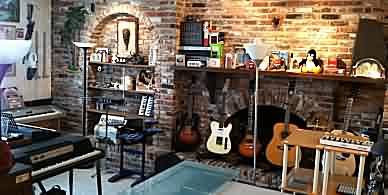 RATTLING
RATTLINGA constant menace is things in the beautiful Nord Imperium making noise on their own, in sympathy with the mighty organ. My beloved virtual organ is loud, if at a level hardly detectable in the clangorous halls of the VTPOers, but things rattle even for me. ... I try to verify it’s not the speakers themselves making these noises, and then give-up, but I have managed to de-rattle a few of the more noticeable decorative offenders. ... And it’s another reason to play softer....
6/18. And then, in the fullness of the weary years, I discovered that my beloved PA speakers compress at high volumes! ... Of course; it’s a feature. Mostly noticeable since I got my miditzer loud reed set-up, but it probably happened before. It’s not so obvious: I step on the gas and it gets louder, but the musical image adjusts at the loudest, mostly cutting down remaining bass components that I haven’t managed to get rid of. Or maybe — well, almost certainly — the speaker does the compression at the input and doesn’t know I turned down the speaker’s bass all the way. ... There were a few obvious solutions: 1. buy bigger speakers; 2. ignore it; 3. play softer. ... #3 appeals, but I’ll probably stick with #2. Although buying stuff is always fun....
But then there’s #4 — I hooked it up wrong! The subwoofer’s got “stereo” speaker outputs which are supposed to be used for the stereo bass-stripped sound, but I had fecklessly just split the stereo feed to the PA & subwoofer, foolishly assuming the PA speakers’d work the way they didn’t. And in the fullness of the grey covid years, that turned-out weirdly to be correct: I realized the subwoofer’s bass-stripped output was only there if it had an amplified speaker input which my gay imperium did not supply. ... But fortunately my laziness prevailed anyway, when I realized I could just use my existing hifi eq — already in place for previous pointless endeavors — to control the PA! Or even spiffier, use my spare FBQ3102! ... So a world of elaborate tone control stalks me, and perhaps louder FFs. ... And it really did sound much better; who knows how much loudness I’ve been wasting on inaudible bass all these months?
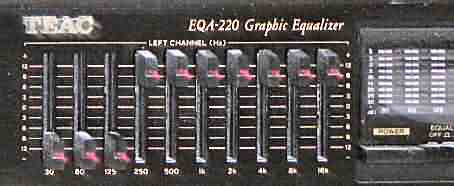 And
then the years stumbled on and it still wasn’t quite right, until
I
realized I should replace the cheap EQ
with
the better FBQ3102
to get more than 6dB
difference between treble/bass
— or, so much easier, just turn-up
the cheap EQ’s treble,
which worked wonderful and now all is perfect — except of course
I’ll have to grovel all over again with the HD400s
and who knows what all, to battle that resurgent sneaky hiss ’n’
hum. ... But (even!) my hwerk 320
sounds
better
now, wonder of wonders. ... Perhaps I should note that I gave-up
long ago
any idea of “flat” i.e. hi-fi-like
response with my beautiful organs — or my hi-fi for that matter.
It’s
a chimaera,
but particularly in the case of the beloved theater organs which
obviously sound like whatever they sound like, quite differently from
different audience positions + hall effects/treatments, etc. So I tune
my EQ to taste....
And
then the years stumbled on and it still wasn’t quite right, until
I
realized I should replace the cheap EQ
with
the better FBQ3102
to get more than 6dB
difference between treble/bass
— or, so much easier, just turn-up
the cheap EQ’s treble,
which worked wonderful and now all is perfect — except of course
I’ll have to grovel all over again with the HD400s
and who knows what all, to battle that resurgent sneaky hiss ’n’
hum. ... But (even!) my hwerk 320
sounds
better
now, wonder of wonders. ... Perhaps I should note that I gave-up
long ago
any idea of “flat” i.e. hi-fi-like
response with my beautiful organs — or my hi-fi for that matter.
It’s
a chimaera,
but particularly in the case of the beloved theater organs which
obviously sound like whatever they sound like, quite differently from
different audience positions + hall effects/treatments, etc. So I tune
my EQ to taste....
Let me now summarize with gay incantations what I have wrought, with a little help from the ingenious Swedes (who built the Nord). ... Prices were @ Amazon.com unless noted otherwise, between 11/25/11 and 3/12 or so; mostly excluding shipping — because I paid some vast sum to be an Amazon “prime” customer, which, if you’re planning scandalous home organ expenditures, isn’t such a terrible idea. ... “?” are optional, probably idiotic — that is, more idiotic — items.
A: The Nord C2: $3,062.12. ... This thing was all dewy innocence and newness in 2011, but then (2/13) it was no longer among us, replaced in the brutal free market with the new super C2D with real drawbars, which I don’t find that enticing — But wait! ... It’s back! ... At Mon 9/1/14 I noticed the C2 non-D at amazon at a higher price: $3,699.00. Which I suppose means it’s doing well, which is good for future support, availability, repair. ... Here in the future @ 4/20, the C2s disappeared again, but the C2D’s just $3000! — in the time of covid19.
 Gone
GoneBut later, still in the time of the ever-Eternal Plague @ 9/21, my beloved C2/C2D has vanished from the world of light, or the instrumental marketplace anyway. Even on ebay all that’s left are ridiculously-costly $600 soft cases. ... Well reverb’s got two @ 5/11/22 for 5 or 6$K, used of course ... pay to play indeed....
In my personal organ universe, I can cruise into the foreseeable future, probably, with my version 4 hauptwerk — i.e., when the Nord bursts into flame, I can play classical music with the hwerk and random keyboards, and I even have a spare pedal board I could resuscitate, no doubt, into glorious 32-note MIDIfication! ... & of course I prefer the Miditzer 260sp for my beloved theater organesque drivel. ... But I must sadly conclude that the Hammond B2 magic is fading, which was what the C2 was mostly bought for, at least by the peasant class out there in the real world, so now the bar bands across the fruited plains will have to use their casio’s “organ stop” for Whiter Shade of Pale, and like it.
Well, a more plausible story is the Hammond SKX is the perfidious enemy before which my beloved C2 fell, so maybe the bar bands still thrive, just without the baroque stops. A hammond skx description claims “32 ranks of Hi-Def Classical Pipe Organ voices” altho I vaguely recall some unwholesome restrictions on their usage in the sk2 days — but the skx manual I just downloaded seems to be OK on that subject. ... But how the skx’s classical stops sound — I have never seen a review, and I have seen one on the Nord’s — favorable, of course. But Sound on Sound’’s 5/19 skx review doesn’t mention the classical stops — which is the normal form for an unfavorable review, i.e. omertic silence — so they’re probably the usual stinko suspects....

B: Nord Pedal Keys 27 aka PK27: $2,201.00 at Sweetwater.com. Amazon didn’t sell them. ... So including the Nord C2, that’s about $5,300 in ~2011, with the rest of the debris making-up another $1000 or so. ... At 5/4/15 the Keys 27 was available at Amazon for $2.5K; same price at Sweetwater. These things aren’t getting cheaper! ... And are presumably discontinued along with the beautiful C2.
C:
Behringer B208D PA speakers, two
for $401.90. The right channel isn’t shown
 and
anyway
the unit that is
shown in the picture is
the pusillanimous B1031A which wasn’t
loud-enough.
... Eventually
I moved the B208Ds up on a table, which improved the stereo image
probably,
but
definitely made them louder
(i.e.
closer to my ears)....
and
anyway
the unit that is
shown in the picture is
the pusillanimous B1031A which wasn’t
loud-enough.
... Eventually
I moved the B208Ds up on a table, which improved the stereo image
probably,
but
definitely made them louder
(i.e.
closer to my ears)....
D?: Behringer FCV100 foot pedal: $32.88 + my endless enhancements. Also there was a power supply I had to get for it from somewhere, $20? or so....
E: Polk Audio PSW505 subwoofer: $321.28 — the crowning glory of the home electronic organ, and pretty-much essential. ... So with the PA speakers that’s about (~2011) $750, + cables + exotic splitters / adaptors or something, to get the audio to both the subwoofer and the speakers.
 A
Power Strip
for the Powered
Speakers: You definitely want
a separate
power strip with an indicator
light
for the power
to
your powered
speakers and subwoofer, and turn it off
before
you turn-off the power to anything
else. When I don’t do that, my speakers make VERY
LOUD
LOUD
NOISES;
amplified
speakers are
supposed to have
gadgets
so they won’t hurt themselves, but I wouldn’t count on it,
and
the
devices
have no
restrictions on inflicting
human
injuries.
... It’s also
a good
plan to turn them on after
the
other stuff, so you can quickly abort
a “million flies”
situation.
A
Power Strip
for the Powered
Speakers: You definitely want
a separate
power strip with an indicator
light
for the power
to
your powered
speakers and subwoofer, and turn it off
before
you turn-off the power to anything
else. When I don’t do that, my speakers make VERY
LOUD
LOUD
NOISES;
amplified
speakers are
supposed to have
gadgets
so they won’t hurt themselves, but I wouldn’t count on it,
and
the
devices
have no
restrictions on inflicting
human
injuries.
... It’s also
a good
plan to turn them on after
the
other stuff, so you can quickly abort
a “million flies”
situation.
... And then, in the Adventure of Miditzer’s Master Gain, I managed to turn-off the system with the loud bang — and the PC of course went bonkers! ... Another reason to avoid the practice....
F, G?: Two Behringer Xenyx 502 mixers: $45? * 2 ==> $90? Like so many busy modern folk, I had these lying around the house. The first unit mixes the Nord audio output with the computer audio. The second provides a headphone output and final volume controls.
H?:
My beloved Behringer BFD equalizer![[9]](nine.png) EQs
the odd organ, and cures any wolf notes
that show up. (But the previous
EQ is depicted.)
EQs
the odd organ, and cures any wolf notes
that show up. (But the previous
EQ is depicted.)
J?:
Noisy Behringer
FEX800 reverb:
$70.60. Originally for the
Miditzer, which
has a built-in, but anemic; but Hauptwerk
shockingly has nothing.
... Then the FEX800 betrayed
me; fortunately
I had
a second
unit upstairs. ... But I had to research-up
another reverb; I like
the FEX800,
but not if it’s going to mutter at me. Although
I must
say when I brought the offending FEX800 upstairs, I couldn’t hear
frying noises until I resorted to headphones
and
turned-up
the gain enough. I supposed it was just one of these level things, Nord
Imperium
versus attic squalor.
... Anyway, I tried
a $100 Alesis Nanoverb 2, which was worse
than the FEX800 even with
the noise!
...
But then an  Alesis
Midiverb
4 was my delight; mostly
’cause it looks
incredibly cool there amidst the Imperium debris, but also
it actually sounds better
than
the FEX800 — it was $190, it should.
... The Midiverb is also much
more complicated but, like my beloved BFD EQ
Alesis
Midiverb
4 was my delight; mostly
’cause it looks
incredibly cool there amidst the Imperium debris, but also
it actually sounds better
than
the FEX800 — it was $190, it should.
... The Midiverb is also much
more complicated but, like my beloved BFD EQ![[9]](nine.png) ,
has presets
so I can dial-up one
of an assortment
of reverbs I’ve
programmed to my exact desires, at least after I’ve figured-out how
it works. ... While I’ve managed
to save 2 or three programs, during the
struggle it makes noises, hum, loud
clicks, and it clicks
even when just switching from one program to another. ... But that’s
just the program adjustment;
the
effect
is still serene and beautiful, and I suppose it’s so hard in our
busy
modern
world for these technology companies to actually finish
their projects. ... But that’s OK; by 9/17, Alesis discontinued
it....
,
has presets
so I can dial-up one
of an assortment
of reverbs I’ve
programmed to my exact desires, at least after I’ve figured-out how
it works. ... While I’ve managed
to save 2 or three programs, during the
struggle it makes noises, hum, loud
clicks, and it clicks
even when just switching from one program to another. ... But that’s
just the program adjustment;
the
effect
is still serene and beautiful, and I suppose it’s so hard in our
busy
modern
world for these technology companies to actually finish
their projects. ... But that’s OK; by 9/17, Alesis discontinued
it....
K?: The organs. The glorious Miditzer 216 or Hauptwerk Paramount 310: $0. A computer to play them: $500 to $5000? ... And ...
USB AUDIO aka DIGITAL AUDIO
Along with the virtual organ software + the computer, a third requirement is “USB Audio” as I’ve been jejunely calling it, which usage probably reflects my provincial preference for laptops. The category is properly “digital audio” with which PCs could be equipped with varying degrees of annoyance/utility long before the USB standard. However, the future definitely belongs to USB or something worse, like USB version 3 or the Apple-interface-of-the-week Thunderbolt, so I will continue ignorantly using the term “USB audio” and to heck with lore and legend....
Both
mitz
and hwerk can
get
along without
USB
audio (what
costs something like $200 or more)
but Hauptwerk’s latency
can
be greatly improved with:
the
gadgets come with “driver” software of widely varying quality
which is supposed to accomplish
this.
...
I
originally used a Behringer
UCA222
@ ~$35, but it
offended
with
an almost-inaudible-but-still-annoying
beeping noise — which I must confess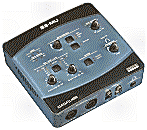 I mistook
for
Hauptwerk’s copy-restriction
tinkling
triangle and annoyed that esteemed
organization
for
a week! — so I took it back upstairs to my
dubious studio
where it has joined the Zoom R16 in my ever-expanding Hall of
Shoddy USB
Audio.
I mistook
for
Hauptwerk’s copy-restriction
tinkling
triangle and annoyed that esteemed
organization
for
a week! — so I took it back upstairs to my
dubious studio
where it has joined the Zoom R16 in my ever-expanding Hall of
Shoddy USB
Audio.![[27]](twentyseven.png) ...
I
then installed
the officially obsolete
EMU 0404,
the
antique gift of the beloved LOL
which stopped
working — became totally
silent
— after a few
weeks; so I swapped ’em back, and the UCA222 continued to beep
inaudibly
and
the
0404 works upstairs, each like a snowflake so intricate and
beautiful....
...
I
then installed
the officially obsolete
EMU 0404,
the
antique gift of the beloved LOL
which stopped
working — became totally
silent
— after a few
weeks; so I swapped ’em back, and the UCA222 continued to beep
inaudibly
and
the
0404 works upstairs, each like a snowflake so intricate and
beautiful....
Some
of the Hauptwerkians
favor the M-Audio brand; which was entangled in
loathsome
Pro Tools
software scams although perhaps that was an unreasonable aversion
and as
soon as Amazon delivered my M-Audio
9900-65145-12 Fast
Track Pro I found out for
myself and it worked good! ... If
you don’t count
it occasionally making an
awful noise like a
million flies. ... I was so horrified
the first time, 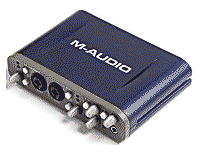 I keep an eagle-eye on
the meters
and saw the second
one coming. ... So it’s probably just some unfortunate M-Audio
power-cycle reset problem — that
must be why
they have the on/off
button on the back, and cycling it off/on has always stopped
horrible
noises. ... But I
was switching the USB
hub
power along
with the Nord and the organ music lights,
but since I’ve left it on all day the million flies
haven’t returned, so it was probably starved for power when those
things happened, and too stupid to turn itself off.
...
A more
harmless idiosyncrasy: on
reboot the
software — which I downloaded from their site, never opening the
CDs —
occasionally emitted a cryptic debug message
“TBIA The data is invalid”
(“Task Bar Icon Application”!)....
I keep an eagle-eye on
the meters
and saw the second
one coming. ... So it’s probably just some unfortunate M-Audio
power-cycle reset problem — that
must be why
they have the on/off
button on the back, and cycling it off/on has always stopped
horrible
noises. ... But I
was switching the USB
hub
power along
with the Nord and the organ music lights,
but since I’ve left it on all day the million flies
haven’t returned, so it was probably starved for power when those
things happened, and too stupid to turn itself off.
...
A more
harmless idiosyncrasy: on
reboot the
software — which I downloaded from their site, never opening the
CDs —
occasionally emitted a cryptic debug message
“TBIA The data is invalid”
(“Task Bar Icon Application”!)....
 And
then the Great
Wheel Turned,
and the Fast Track gave way to a Behringer
UMC204hd which was,
functionally, all but identical to the Fast Track, except of course it
worked in Windows 10.
And, like everything
else in Windows 10, it’s noticeably slower than the
beloved/hideously-obsolete
win7.
And
then the Great
Wheel Turned,
and the Fast Track gave way to a Behringer
UMC204hd which was,
functionally, all but identical to the Fast Track, except of course it
worked in Windows 10.
And, like everything
else in Windows 10, it’s noticeably slower than the
beloved/hideously-obsolete
win7.
TENDENCIES?
I think in general the USB audio gadgets tend to be optimized for getting audio into the computer, while the virtual organist wants to get it out. So the USB gadgets are encumbered with microphone inputs and other useless frippery, while the outputs are reduced to “monitoring” — listening to the wretched EDM gunk you’re supposed to have created with your DAW and the inputs and what-not. This monitoring output is never actually used in the final recorded gunk, and perhaps is shamefully neglected like so many home organist interests. ... Perusing the USB audio bazaars, I’d guess interfaces with MIDI are the more likely category for devotees of virtual instruments which require MIDI anyway — i.e., like the beloved virtual organs — and might be a little more likely (?) to produce better latency / audio monitoring....

 Note
that
the hard-core
virtual organist sniffs
at USB
and laptops, going for a desktop, preferably a Mac Pro, the
totally obsolete
model
with plug-in
card(s) and multiple
audio
(and MIDI)
channels — the current Mac Pro titters
at plug-in cards — well, that’s the <2019 model. The new
mac
pro’s
got ’em....
Note
that
the hard-core
virtual organist sniffs
at USB
and laptops, going for a desktop, preferably a Mac Pro, the
totally obsolete
model
with plug-in
card(s) and multiple
audio
(and MIDI)
channels — the current Mac Pro titters
at plug-in cards — well, that’s the <2019 model. The new
mac
pro’s
got ’em....
The M-Audio interface seemed annoyingly noisy and after a fair amount of wheel-spinning I found that putting one of the admirable Behringer HD400s on the M-Audio audio output to my mixer much reduced it! There’s still white noise, which I suspect is a general condition for VSTis and hardly noticeable in the modern hip-hop click-tracked recording/DJ environment or with the intentionally-noisy but beloved virtual organs for that matter, but the HD400 suppressed annoying hum and other debris....
EVER MORE USB: KEYBOARD INPUT
To confuse the innocent further, note that the modern virtual organ computer has another requirement: at least one (probably USB) MIDI input from the keyboards/pedals, so there’s some way to play the thing, for which I provide inadequate hints & rumours, for Miditzer at least, elsewhere.
... Ever-elaborating USB connections often require a USB hub, a fixture pretty-much necessary with a laptop, and which I realize I’ve kept secret in this extensive technical summary up to now. ... And so that’s all I know about USB/MIDI and more. ... Well I should note that rumor/delusion will report that a particular gadget won’t work plugged into a USB hub (i.e. instead of “directly”) — which usually means it won’t work, period, but there have been wandering actual failures under that heading, I suppose....
And then as the hideous covid-afflicted years crawled by, my beloved organ-of-a-thousand cables stuttered, cranky and obviously broken, intermittently 10 or twenty times a minute although totally unpredictable. And I was sad, and knew not where to turn — before realizing that of course I should blame the problem and not imagine it was somehow my fault! ... I mean this is a windows 10 laptop which I have fecklessly left connected to the wireless so it’d get its regular Usux™ upf--ks! ... Stuttering!?!?! ... Usux™ loves stuttering; it’s not their stupid problem, is it, somehow?!?!?! ... Of course not. ... So I will try various pitiful software triages, uninstalling/reinstalling etc., and/or buying another USB audio gadget. ... But the beautiful no-stinking-USB-audio Nord itself still plays wonderfully, even in its pitiful discontinued state. ... But the snooty hauptwerk stutters along with my beloved mitz....
 ...
And so another computer brand goes off the owenlabs approved list: Acer
will darken my doors no more. Of course that only leaves Dell, which is
sad, but then who needs a PC when one has got a cell phone? ... Anyway
I uninstalled several Usux updates, and after two or three I came to
the
usual won’t-uninstall-’cause-we’re-a-monopoly piece of
dog
doo doo, and
away it goes! ... But this time, the “new” Dell — actually
a used
one I got cheap what seems to work good — well, the Dell’ll
get its wireless
turned-off to start
with. ...
And when it stutters and won’t uninstall enough upf--ks,
then maybe I’ll buy a Dell Windows 7 machine — that’ull
show
’em! ... The organistas
were (are?) all convinced the virtual organs thirst for heavy iron, but
the cruddy laptops I’ve used so far including at least one win7 unit
seemed to perform OK — until our brave new era’s stuttering,
which no
doubt requires another 2 billion megaflops or at least a fabulously
more expensive Usux™ OS.
... Although
it’s possible the organistas’
beloved
Macintosh doesn’t stutter, but the Mitz
definitely
doesn’t work on the macintosh, so who cares?!
...
And so another computer brand goes off the owenlabs approved list: Acer
will darken my doors no more. Of course that only leaves Dell, which is
sad, but then who needs a PC when one has got a cell phone? ... Anyway
I uninstalled several Usux updates, and after two or three I came to
the
usual won’t-uninstall-’cause-we’re-a-monopoly piece of
dog
doo doo, and
away it goes! ... But this time, the “new” Dell — actually
a used
one I got cheap what seems to work good — well, the Dell’ll
get its wireless
turned-off to start
with. ...
And when it stutters and won’t uninstall enough upf--ks,
then maybe I’ll buy a Dell Windows 7 machine — that’ull
show
’em! ... The organistas
were (are?) all convinced the virtual organs thirst for heavy iron, but
the cruddy laptops I’ve used so far including at least one win7 unit
seemed to perform OK — until our brave new era’s stuttering,
which no
doubt requires another 2 billion megaflops or at least a fabulously
more expensive Usux™ OS.
... Although
it’s possible the organistas’
beloved
Macintosh doesn’t stutter, but the Mitz
definitely
doesn’t work on the macintosh, so who cares?!
And so this morning on my “new” antique Dell Win10 stuttered not. For a few chords. ... And see the surpassingly-easy resuscitation of my $0 MIDIox/Mitz necromancy....
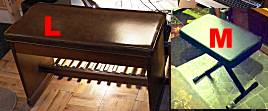
L?: My pitiful Commodore bench. Priceless. ... Which, I realized after months, was the wrong height and so went back to ...
M: On Stage KT7800 Plus Keyboard Bench: $36.91. Adjustable-height and really works quite well, once you wrap some duct tape around a foot to suppress wobbling. ... But it’s still too wobbly, particularly extended to an adequate height, so then I replaced it with my DK40 bench which, I deluded myself, is just right. There are more substantial adjustable benches than the KT7800 for sale, but it’s probably the cheapest way to try-out different heights. ... And in the great march of organ tinkering, I finally mutilated the Commodore bench surprisingly successfully, and it was as it had been, minus two inches. ... I might add that my measure of organ bench adjustment merit is that the heel and sole can rest comfortably on the white pedals; which I confess is something that didn’t explicitly occur to me in years of incompetent organ playing. ... And then in the senseless tragedy of the 3rd keyboard, I height-adjusted it back and, I must admit, even ’though my heels do not rest so easily on the white pedals, it’s still OK....
 Various
Other $s: The inevitable 5 million cables. ... The
ridiculous
plywood table I built, and the
furniture I bought
— actually, I was
startled to realize my homemade table wasn’t that
ridiculous, because normal furniture typically doesn’t provide the
required knee clearance, so it’s just as if I knew what I was
doing! ... Alternately, Nord makes its own stand for the C2, + at
Amazon
you
can
select the “musical instrument” department and search for “keyboard
table” to see a useful selection I didn’t notice until
too
late. ... But of
course they aren’t constructed of authentic plywood.
Various
Other $s: The inevitable 5 million cables. ... The
ridiculous
plywood table I built, and the
furniture I bought
— actually, I was
startled to realize my homemade table wasn’t that
ridiculous, because normal furniture typically doesn’t provide the
required knee clearance, so it’s just as if I knew what I was
doing! ... Alternately, Nord makes its own stand for the C2, + at
Amazon
you
can
select the “musical instrument” department and search for “keyboard
table” to see a useful selection I didn’t notice until
too
late. ... But of
course they aren’t constructed of authentic plywood.
Anyway, it all adds up. Excluding the “?”-marked items above and the “Various Other $s”, to around $6,200. ... Note that this sum doesn’t include the lessons administered by my vast ignorance, for instance running through speaker systems like water until the sublime perfection of the subwoofer + the True Loudness. ... And of course I’ve forgotten numerous exciting and puzzling items: oh see to the left of the two volume pedals at “D”, for instance, there’s a piano-like sustain pedal, which for some reason the Nord combo organs support; and I had one around (since replaced with a more functional, if less picturesque, square pedal)....
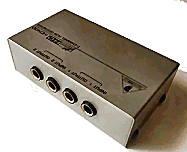 The
Excellent Behringer HD400
The
Excellent Behringer HD400Numerous
Behringer
HD400 “hum
destroyer” ground-lifting stereo audio transformers @ ~$25 each seem
to
suppress noise/hum in many corners of the Imperium’s vast complexity.
... Most recently at
the mixer input from the M-Audio
interface + a different mixer
input
from the volume pedal.
Whereupon
the “too loud” level — my mark of adequacy — is
also almost
quiet-enough.
A miracle! ... It’s not all beer and skittles, however; these things
really
are
transformers, so they shouldn’t
go next to AC cords, extensions, etc. or they make
hum!
... And here I thought they were supernatural. ... But moving the
HD400s
a few inches away from the AC seems to fix that. ... 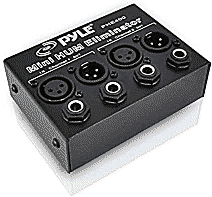 Incidentally
this
proliferation of HD400s is just the Universe’s way of telling me
I
should’ve used expen$ive
professional equipment with
balanced
input/ouput. ... I
should mention a cheaper maybe-better competitor, the Polk Compact Mini
Hum Eliminator Box, what I bought one of but didn’t test yet, ’though
I’m reasonably confident future imperium
convulsions will give it a chance. It’s great claim to fame, aside
from being cheaper, is the addition of XLR fixtures.
Incidentally
this
proliferation of HD400s is just the Universe’s way of telling me
I
should’ve used expen$ive
professional equipment with
balanced
input/ouput. ... I
should mention a cheaper maybe-better competitor, the Polk Compact Mini
Hum Eliminator Box, what I bought one of but didn’t test yet, ’though
I’m reasonably confident future imperium
convulsions will give it a chance. It’s great claim to fame, aside
from being cheaper, is the addition of XLR fixtures.
... And then I discovered the Miditzer’s master gain, a great aid in gain staging my beautiful organs....
Sunday 7/6/25 10:36 am
